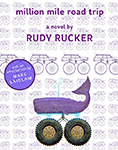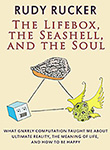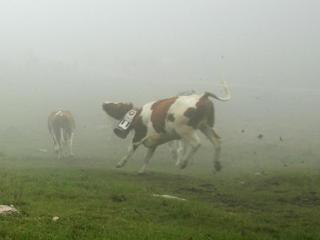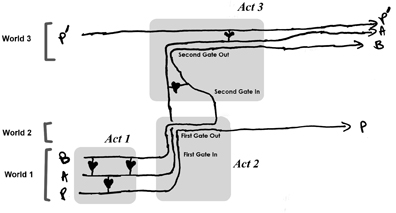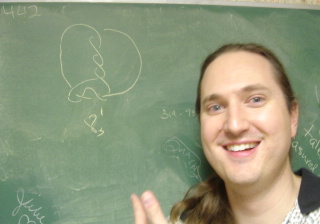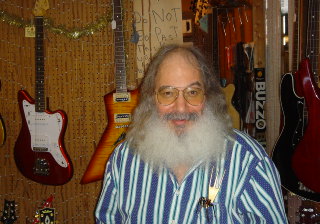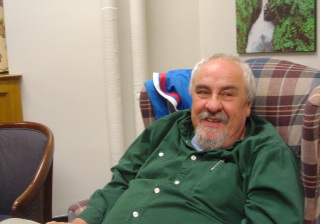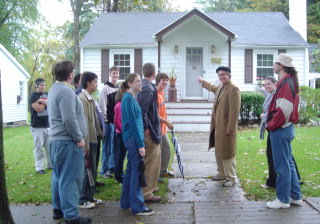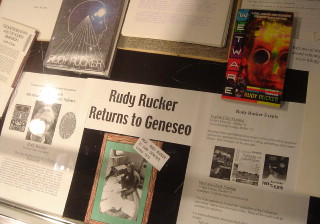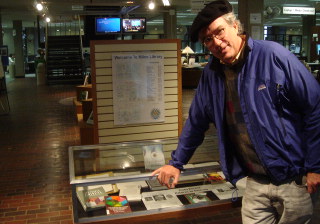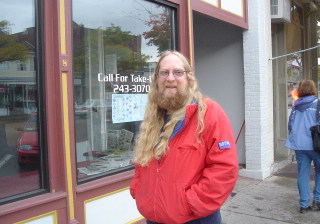My God, is Bush going to win this election? I thought it was impossible, but I'm not seeing the Kerry landslide I was hoping for. And where do they get off switching Republican and Democrat to “red and blue” states? Before the Stolen Election of 2000, the colors were the other way around. Doesn't anyone even remember that? What comes after 1984? 2004!
Simmer down, old-timer.
Here's an excerpt from an email interview with me by Arianna Dagnino of Milan, Italy, for L'Espresso magazine. The topics relate to blogging.
The Q and A numbers are based on my uniform email interview numbering; I keep all the accumlated email interviews in a single online document called All the Interviews
Q 154. I'm interested in the notion of recording a person's lifelong sensory impressions on an implanted chip. Let's also suppose that the chip is equipped with a program that interviews the individual and records their internal monologue about these recorded events. Do you think this is a possible technology?
A 154. This is a good topic to ask me about, as I've often written about this concept in my science-fiction — I first presented the idea in my 1986 short story, “Soft Death”. I use the word “lifebox” to describe the kind of life-recording device you're talking about. It's a notion I'm still thinking about; in fact, I just finished writing a long nonfiction book called The Lifebox, the Seashell, and the Soul. I also have quite a bit about lifeboxes in my 1999 futurological novel Saucer Wisdom.
To begin with, I think we need to be clear that using implanted chip technology for a lifebox is out of the question. The implanted chip is a metaphor, a visual symbol that a director might use to represent a lifebox in a movie. But in practice, there will never be a successful industry based on putting brittle hardware into people's bodies. A chip in your body would lead to computer virus attacks, a complete loss of privacy, and endless breakdowns and upgrades. Nobody is that stupid. This said, I do very strongly feel that we will soon see non-invasive lifebox technology.
A feasible near-term realization of an image-oriented lifebox would be to wear a tiny head-mounted video camera capable of uploading sounds and images to a high-volume database. The camera could be in, for instance, the frame of your glasses. A less intense approach is to use the camera in your cell phone, and to take photographs that are uploaded to a database.
Images alone don't tell your eventual audience enough. A lifebox needs to preserve some of your words, as words are so good at expressing your thoughts. As well as comments on images, you'd want to record long blocks of independent text describing your memories, ideas and fantasies.
One approach for preserving text is to record voice messages. But written messages are easier to absorb; a reader can scan through text very quickly. In either case, a cell-phone or computer-based lifebox device could assist you with this by using some rudimentary AI to ask you relevant questions. Such as this email interview.
Q 155. When do you foresee the lifebox to become a mass phenomenon, with hundreds of thousands of digital personalities? Who will care about them?
A 155. I think it's already happening in the form of blogs. Blogging is a mass phenomenon. A blog is a kind of lifebox: a digital model of the author's actions and thoughts.
Note that blogs contain both images and words — which are carefully arranged. People might like to imagine that they could create a lifebox model of themselves just by taking a hundred pictures a day or by wearing a video camera. But they'd be wrong. The pen is as mighty as the camera. And editing is essential. Without editing, the Venus de Milo is a block of marble.
The blog or the lifebox is a form of art, a kind of self-expression. Most of us aren't blessed with the ability to create art with broad appeal. Nearly everybody writes and photographs a little, but only a few get published or appear on museum walls. Why would it be any different with the lifeboxes?
If you don't analyze the situation very deeply, you might imagine that a lifeboxing tool could be so well-automated that it produces a gripping biography of anyone's life. But the production of art is an unsolvable programming program!
Part of the problem is that art is a moving target. As soon as something becomes easy, we expect more. We only have the time and energy to look at a very limited number of works by other people. This leads us to your second question, “Who will care about these lifeboxes?” Hardly anyone.
Most lifeboxes are going to be viewed only by the authors' friends and family. But this is still enough to produce a mass market for lifeboxing software and hardware. If your grandchildren can know a little more about you, then maybe you've accomplished enough.
After all, it's very common for retired people to want to write a little memoir so that their family can remember them better. Having a little cell-phone-sized device which asks you questions would be a pleasant way to carry out such a project.
Q 156. Will the use of the lifebox affect the way we make experiences so as to have memories to cherish? And what about the bad experiences, the ones we desperately want to forget?
Q 156. Let me invent a very short story.
A guy on a business trip goes to a prostitute. He uses his cell phone to take a picture of them having sex. She charges him a little extra for that, but otherwise she doesn't care. For her it's free advertising. Now the guy is originally planning to save the picture just for himself, to gloat over, but he can't resist forwarding a copy of the file to his best friend Luigi back home. But Luigi forwards the picture to the guy's wife! And then Luigi goes to visit the wife in person. The wife is so mad at her husband that she has sex with Luigi, and cell-phones her husband a photo of them in action.
This cautionary tale gives you an idea of why nobody would want an implanted lifebox. You could never be a hundred percent sure that it wasn't recording something you'd rather not publicize. It's best to keep your most personal memories in one place only: the intimate tangles of your neurons.
November 1, 2004
Here's my Halloween pumpkin.

Sylvia and I had a good time last night. Went to this show called the Haunted Barn in Hunter's Point and saw Rudy and Penny helping.
It was fun. This guy built a giant “Mousetrap” game in the backyard, this Rube Goldberg set-up. Dropped a 4,000 pound safe on a pile o punkins!
They had a Satan revival outside the Haunted House, a funhouse mirror image of Jerry Fallwell's revival outside of his “Scaremare” haunted house in Lynchburg when we lived there.
I also saw a tattoo show on Nob hill. A 54-year old woman naked with tatooes over every square millimieter. She looked like she was dressed.
Good old SF.
I love to see things like the Haunted House, all those young people, life going on. And so human-scale and festive, so noncoroporate. Just like the Middle Ages, like a Bruegel picture, my supreme idea of a good time.
And, hey, check this out, a high-snootin' fashion model from the Barneys New York, Autumn Days catalog reading my book! Thanks to John Oakes for spotting this.



